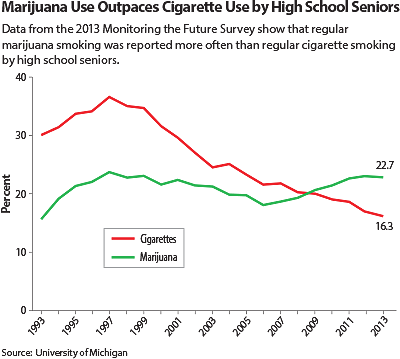Though an annual report on the prevalence of teenage substance use revealed some positive findings regarding alcohol and tobacco use, it also raised concerns regarding use by U.S. adolescents of other substances—at a level pointing to the need for major intervention.
On December 18, 2013, the National Institute on Drug Abuse (NIDA) held its end-of-year teleconference discussing the results of the Monitoring the Future (MTF) survey—a yearly evaluation of drug, alcohol, and tobacco use and attitudes toward such use among adolescent students nationwide. The survey was funded by NIDA and conducted by the University of Michigan.
“This year’s survey offered some very good surprises in the positive direction, while alerting us to areas where we need to keep paying attention,” said NIDA Director Nora Volkow, M.D.
The 2013 MTF survey included 45,449 participants—8th, 9th, and 12th graders—from 395 public and private schools. The survey required adolescents to report their drug use behaviors across three time periods: lifetime, past year, and past month.
Lloyd Johnston, Ph.D., principal investigator of the MTF survey and the Angus Campbell Collegiate Research Professor at the Institute for Social Research at the University of Michigan, has been working with the survey since its inception in 1975 and said that he is amazed by the diversity of drugs that arise in youth populations. “Our questionnaires have gotten longer,” Johnston stated during the teleconference. “There are so many drugs that we ask about . . . over 50 classes and subclasses of drugs, currently.”
Johnston explained that unfortunately most drugs do not leave the substance list once they are added to the questionnaire. “There’s always a concern about the new threats [of drugs] and the danger that we don’t know enough about them to caution people on use of those substances.”
Designer, Prescription Drug Use Decrease
Synthetic marijuana, bath salts, and salvia are some of the newer drugs that were added to the MTF questionnaire over the past decade. Data from the latest survey showed a 30 percent decrease in synthetic marijuana use among teenagers compared with the prior year.
Volkow speculated that the decline may be attributed to the media. “There have been several reports in a relatively short period of time of individuals smoking synthetic marijuana [and] ending up with strokes. And there have been, of course, [reports of] some fatalities,” she told Psychiatric News.
In addition to a downward trend in synthetic marijuana use, MTF data also showed a decline in the use of salvia, a hallucinogenic opioid and dopamine receptor agonist that is derived from the plant salvia divinorum. Though a downward trend was not observed in adolescents’ use of bath salts—which has remained relatively low since its addition to the survey—the designer drug did receive the sharpest increase among all substances that the teenagers viewed as dangerous. Other substances that were used less often than shown in previous MTF surveys were prescription drugs such as psychotropic and pain medications, as well as inhalants, alcohol, and tobacco.
“This is very good news and probably reflecting attention of the media to the adverse consequences that may have changed the attitudes [of the youth],” said Volkow.
However, NIDA’s worries about the extent of adolescent substance use are far from over.
Increase in Regular Marijuana Use Found
The MTF survey reported that about 39 percent of 12 graders view marijuana use as harmful, down from the prior year’s rate of 44 percent. Survey responses also showed that daily use of marijuana among adolescents has increased by 63 percent since 1993.
“More teens are now smoking marijuana than smoking cigarettes,” said R. Gil Kerlikowske, director of the Office of National Drug Control Policy, at the teleconference. “Science clearly demonstrates that marijuana is not a benign substance. It hampers academic performance. It impairs driving. It impacts productivity. And for some to say that it is less dangerous than other substances is a ridiculous statement.”
For the first time in the survey’s history, he noted, evidence suggested that laws legalizing marijuana for medicinal purposes may contribute to the rate of marijuana use. According to the study, 34 percent of marijuana-using high school seniors living in states with medical marijuana laws reported obtaining the drug through someone else’s marijuana prescription.
Kerlikowske said that as more legislation is passed to use marijuana legally—both medically and recreationally—the most powerful tool to remedy this problem is prevention education, which will save lives and lower health care cost.
“Research demonstrates that if we can prevent young people from using drugs and alcohol through their teenage years, the likelihood of them developing substance use disorders [in adulthood] drops dramatically. But we know from prevention research that it has to be consistent,... age specific,... and over a period of years.”
Kerlikowske charged physicians, researchers, teachers, and parents with recommitting to bolstering education and prevention efforts to ensure that America’s youth will have the opportunity to lead a healthy life that is not hindered by drug use. ■

